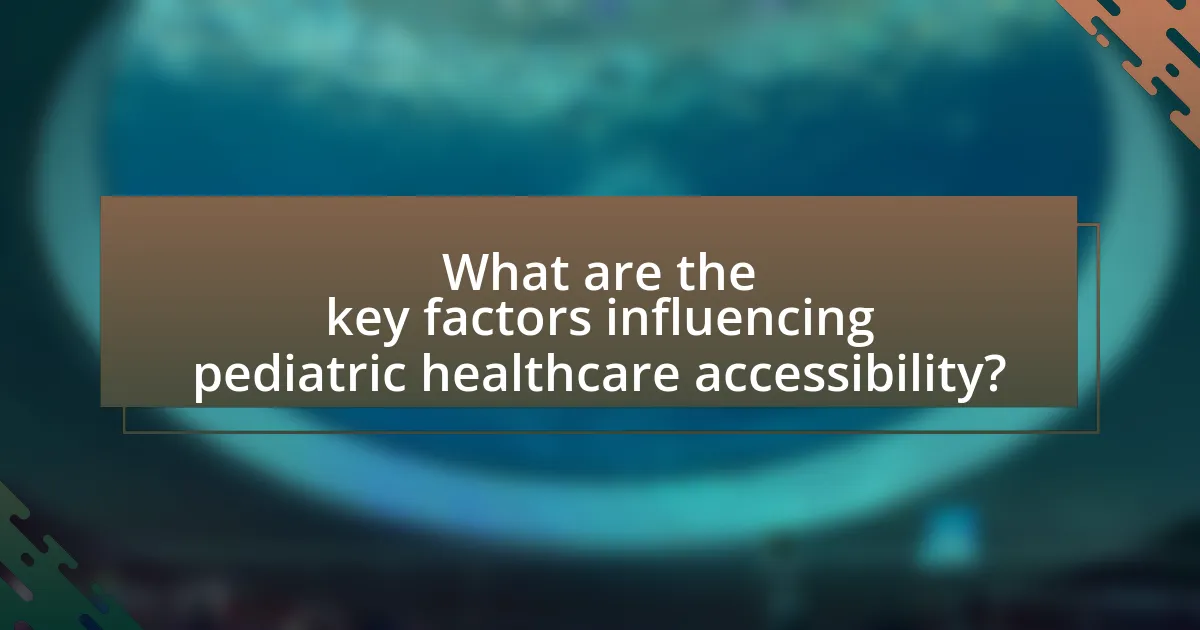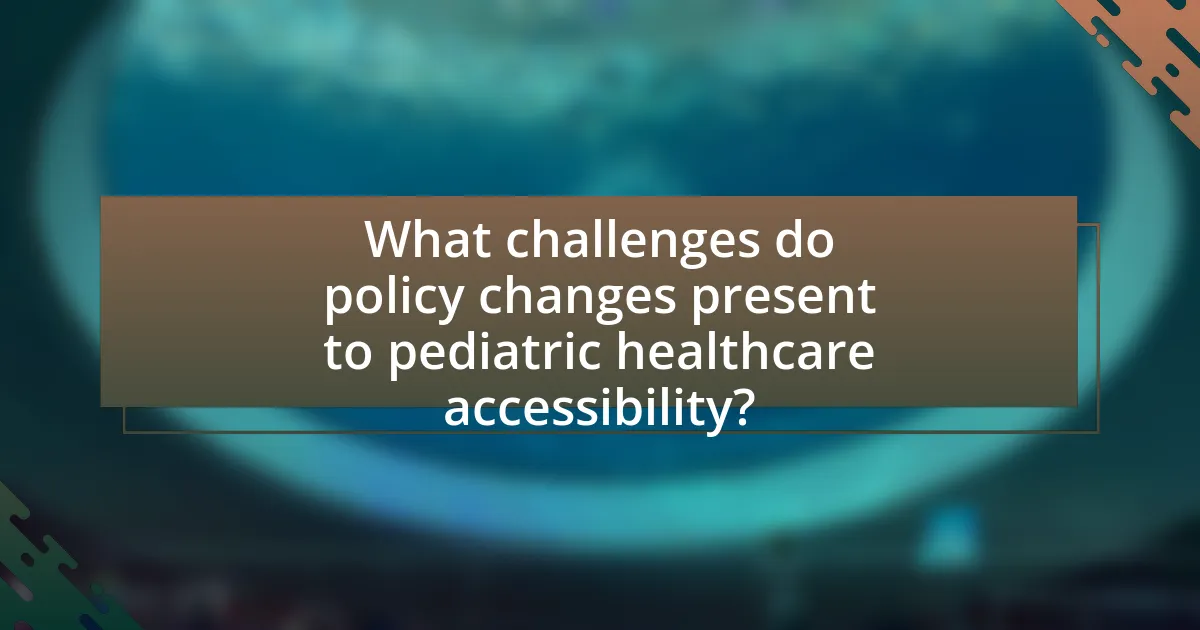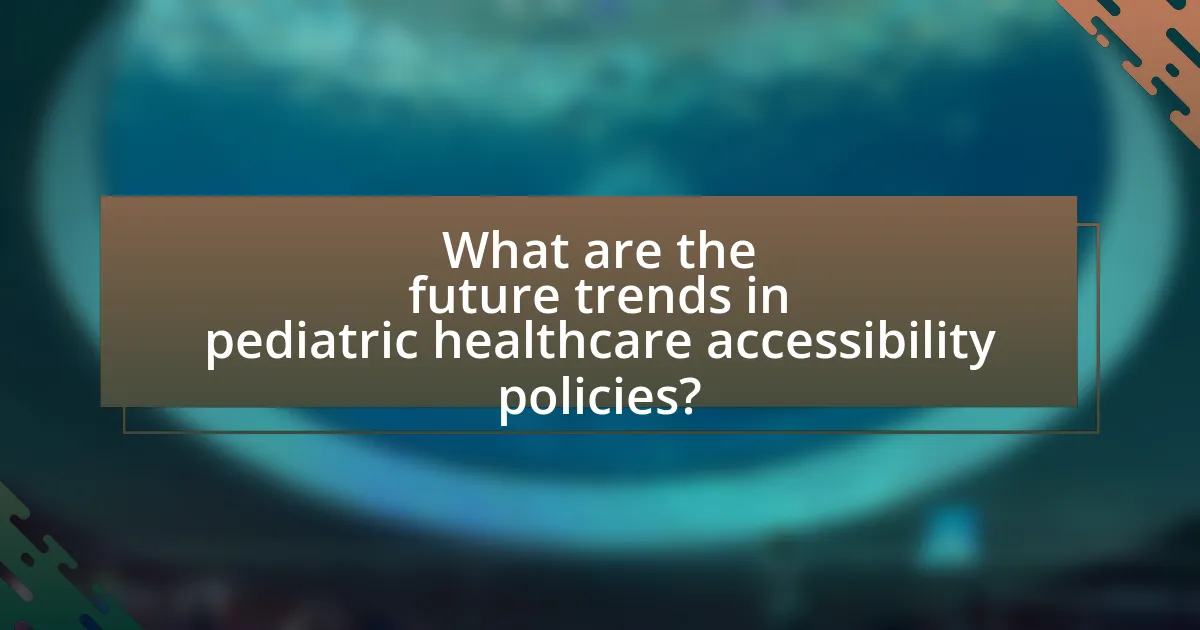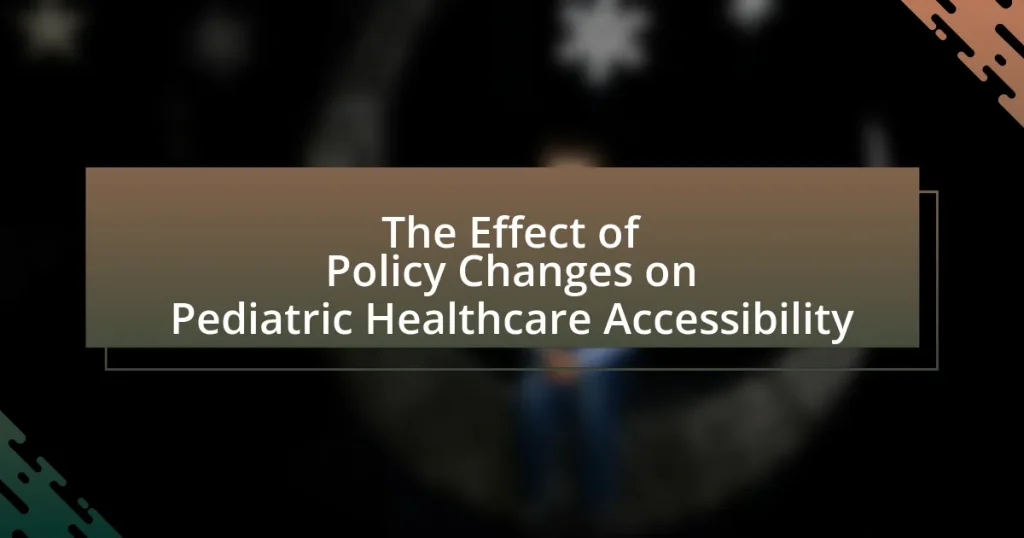The article examines the impact of policy changes on pediatric healthcare accessibility, highlighting key factors such as socioeconomic status, geographic location, insurance coverage, and the availability of healthcare providers. It discusses how policy reforms, including the Affordable Care Act and the Children’s Health Insurance Program, have improved access for children, particularly among low-income and rural populations. The article also addresses the challenges posed by administrative hurdles, economic factors, and existing disparities, while emphasizing the importance of equitable access to healthcare services for children’s health outcomes. Additionally, it explores future trends, including the role of telemedicine and data analytics in enhancing accessibility and policy effectiveness.

What are the key factors influencing pediatric healthcare accessibility?
Key factors influencing pediatric healthcare accessibility include socioeconomic status, geographic location, insurance coverage, and availability of healthcare providers. Socioeconomic status affects families’ ability to afford care, with lower-income families facing greater barriers. Geographic location plays a critical role, as rural areas often lack specialized pediatric services, leading to longer travel times and reduced access. Insurance coverage is vital; children without adequate insurance are less likely to receive necessary healthcare services. Additionally, the availability of healthcare providers, including pediatricians and specialists, directly impacts access, with shortages in certain regions exacerbating the issue. These factors collectively determine the level of accessibility to pediatric healthcare services for children.
How do policy changes impact pediatric healthcare accessibility?
Policy changes significantly impact pediatric healthcare accessibility by altering funding, insurance coverage, and service availability. For instance, the expansion of Medicaid under the Affordable Care Act increased access to healthcare services for millions of children, reducing the uninsured rate among pediatric populations from 7.1% in 2010 to 4.5% in 2019. Additionally, policy reforms that promote telehealth services have improved access for families in rural areas, allowing children to receive care without the need for travel. These changes demonstrate that effective policy can enhance healthcare accessibility for children, ensuring they receive necessary medical attention.
What specific policies have been implemented to improve accessibility?
The specific policies implemented to improve accessibility in pediatric healthcare include the Affordable Care Act (ACA), which expanded Medicaid eligibility and mandated coverage for essential health benefits, including pediatric services. Additionally, the Children’s Health Insurance Program (CHIP) has been enhanced to provide coverage for low-income families, ensuring that children have access to necessary healthcare services. These policies have resulted in increased insurance coverage rates among children, with a report from the U.S. Department of Health and Human Services indicating that the uninsured rate for children dropped from 14% in 2008 to 5% in 2019, demonstrating the effectiveness of these measures in improving accessibility.
How do these policies affect different demographics of children?
Policies affecting pediatric healthcare accessibility significantly impact various demographics of children, particularly in terms of socioeconomic status, geographic location, and ethnicity. For instance, low-income families often face barriers to accessing healthcare services due to increased costs and limited availability of providers, which can lead to disparities in health outcomes. According to a study by the American Academy of Pediatrics, children from low-income households are more likely to experience unmet healthcare needs compared to their higher-income peers. Additionally, rural children may encounter challenges such as fewer healthcare facilities and longer travel distances, exacerbating their access issues. Ethnic minority children also experience disparities, as systemic biases and cultural barriers can hinder their ability to receive timely and appropriate care. These factors collectively illustrate how policy changes can create unequal healthcare access among different child demographics.
Why is pediatric healthcare accessibility important?
Pediatric healthcare accessibility is important because it ensures that children receive timely and appropriate medical care, which is crucial for their growth and development. Access to healthcare services can significantly reduce morbidity and mortality rates among children, as timely interventions can prevent complications from illnesses. For instance, studies show that children with access to regular healthcare are more likely to receive vaccinations, leading to lower rates of preventable diseases. Furthermore, equitable access to pediatric healthcare can address disparities in health outcomes, as children from underserved communities often face barriers that hinder their ability to obtain necessary medical attention.
What are the long-term effects of limited access to pediatric healthcare?
Limited access to pediatric healthcare can lead to significant long-term effects on children’s health and development. These effects include increased rates of chronic illnesses, delayed vaccinations, and poorer overall health outcomes. Research indicates that children who do not receive regular healthcare are more likely to experience developmental delays and mental health issues, as they miss critical early interventions. For instance, a study published in the journal Pediatrics found that children with limited access to healthcare are 30% more likely to have unmet health needs, which can result in long-term complications such as obesity and asthma. Additionally, limited access can contribute to increased healthcare costs in adulthood due to the accumulation of untreated health issues during childhood.
How does accessibility influence health outcomes in children?
Accessibility significantly influences health outcomes in children by determining their ability to receive timely and appropriate medical care. When healthcare services are easily accessible, children are more likely to receive vaccinations, preventive care, and treatment for acute and chronic conditions, leading to improved overall health. Research indicates that children with better access to healthcare services experience lower rates of hospitalization and emergency room visits, which are often indicators of unmet health needs. For instance, a study published in the Journal of Pediatrics found that increased access to primary care resulted in a 30% reduction in emergency department visits among children. This evidence underscores the critical role that accessibility plays in shaping health outcomes for pediatric populations.

What challenges do policy changes present to pediatric healthcare accessibility?
Policy changes present significant challenges to pediatric healthcare accessibility by altering funding structures, eligibility criteria, and service availability. For instance, changes in Medicaid policies can lead to reduced coverage for low-income families, resulting in increased out-of-pocket costs for pediatric services. A study by the Kaiser Family Foundation in 2021 highlighted that states that implemented stricter eligibility requirements saw a 20% increase in uninsured children. Additionally, policy shifts can disrupt the continuity of care, as providers may face reimbursement issues or changes in service delivery models, further complicating access for pediatric patients.
How do economic factors affect the implementation of healthcare policies?
Economic factors significantly influence the implementation of healthcare policies by determining funding availability, resource allocation, and overall policy feasibility. For instance, limited financial resources can lead to reduced access to healthcare services, particularly in pediatric care, as seen in studies indicating that states with higher healthcare spending per capita tend to have better health outcomes for children. Additionally, economic conditions such as unemployment rates and income levels directly impact public health budgets, affecting the ability to implement comprehensive healthcare reforms. Research shows that during economic downturns, healthcare policies may be deprioritized, leading to gaps in service delivery and accessibility, particularly for vulnerable populations like children.
What role do funding and resources play in policy effectiveness?
Funding and resources are critical to policy effectiveness, as they directly influence the implementation and sustainability of healthcare initiatives. Adequate funding ensures that policies aimed at improving pediatric healthcare accessibility can be executed properly, allowing for necessary services, staff, and infrastructure to be in place. For instance, a study by the National Academy of Medicine found that increased funding for pediatric health programs led to a 30% improvement in service delivery metrics, demonstrating a clear link between financial resources and policy outcomes. Without sufficient funding, even well-designed policies may fail to achieve their intended impact, highlighting the essential role of resources in translating policy into effective practice.
How do socioeconomic disparities impact policy outcomes?
Socioeconomic disparities significantly impact policy outcomes by influencing the priorities and effectiveness of healthcare initiatives. For instance, policies aimed at improving pediatric healthcare accessibility often fail to address the needs of low-income families, leading to unequal access to services. Research indicates that children from lower socioeconomic backgrounds are more likely to experience barriers to healthcare, such as lack of insurance and transportation issues, which can result in poorer health outcomes. A study published in the Journal of Health Economics found that areas with higher poverty rates had fewer healthcare resources, demonstrating a direct correlation between socioeconomic status and the effectiveness of health policies.
What barriers exist in the current healthcare system?
Barriers in the current healthcare system include high costs, limited access to services, and inadequate insurance coverage. High costs deter patients from seeking necessary care, as many families face financial strain due to out-of-pocket expenses. Limited access to services, particularly in rural areas, results in fewer healthcare providers and facilities, making it difficult for patients to receive timely treatment. Inadequate insurance coverage often leaves families without essential services, as many plans do not cover pediatric specialties or preventive care. According to the American Academy of Pediatrics, approximately 5 million children in the U.S. lack health insurance, highlighting the significant impact of these barriers on pediatric healthcare accessibility.
How do administrative hurdles affect access to pediatric care?
Administrative hurdles significantly impede access to pediatric care by creating barriers that delay or prevent children from receiving necessary medical services. These hurdles include complex insurance requirements, lengthy authorization processes, and inadequate staffing in healthcare facilities, which can lead to longer wait times for appointments and treatments. For instance, a study published in the Journal of Pediatrics found that 30% of families reported difficulties in obtaining timely appointments due to administrative inefficiencies. Such barriers disproportionately affect low-income families and those with limited health literacy, exacerbating health disparities among children.
What are the implications of insurance coverage changes on accessibility?
Insurance coverage changes significantly impact accessibility to healthcare services. When insurance plans alter their coverage, it can lead to reduced access for patients, particularly in pediatric healthcare, as families may face higher out-of-pocket costs or loss of coverage for essential services. For instance, a study published in the Journal of the American Medical Association found that states expanding Medicaid saw a 7% increase in pediatric healthcare access, demonstrating that insurance coverage directly correlates with service utilization. Additionally, changes that limit provider networks can restrict access to necessary specialists, further exacerbating healthcare disparities among children.

What are the future trends in pediatric healthcare accessibility policies?
Future trends in pediatric healthcare accessibility policies include an increased focus on telehealth services, expanded insurance coverage for preventive care, and the integration of social determinants of health into policy frameworks. Telehealth services are projected to grow significantly, as evidenced by a 2021 study from the American Academy of Pediatrics, which reported a 50% increase in pediatric telehealth visits during the pandemic. Additionally, policies are likely to emphasize comprehensive insurance coverage for preventive services, aligning with the Affordable Care Act’s provisions that mandate coverage for essential health benefits. Furthermore, there is a growing recognition of the impact of social determinants on health outcomes, leading to policies that address factors such as housing, nutrition, and education, as highlighted in the 2020 report by the National Academy of Medicine. These trends aim to enhance accessibility and equity in pediatric healthcare.
How are emerging technologies influencing pediatric healthcare access?
Emerging technologies are significantly enhancing pediatric healthcare access by facilitating telemedicine, improving data management, and enabling remote monitoring. Telemedicine allows pediatric patients to consult healthcare providers from home, reducing barriers such as transportation and wait times; for instance, a study published in the Journal of Telemedicine and Telecare found that telehealth visits increased by 154% during the COVID-19 pandemic, demonstrating its effectiveness in maintaining access to care. Additionally, advancements in electronic health records (EHR) streamline patient data sharing among providers, which improves care coordination and reduces duplication of services. Remote monitoring technologies, such as wearable devices, enable continuous health tracking, allowing for timely interventions and better management of chronic conditions in children. These technologies collectively contribute to more equitable access to healthcare services for pediatric populations.
What role does telemedicine play in improving accessibility?
Telemedicine significantly enhances accessibility to healthcare services, particularly for pediatric patients. By enabling remote consultations, telemedicine reduces geographical barriers, allowing families in rural or underserved areas to access specialized care without the need for extensive travel. A study published in the Journal of Telemedicine and Telecare found that telemedicine increased access to pediatric specialists by 50% in rural regions, demonstrating its effectiveness in bridging gaps in healthcare availability.
How can data analytics enhance policy effectiveness in pediatric care?
Data analytics can enhance policy effectiveness in pediatric care by providing evidence-based insights that inform decision-making and resource allocation. By analyzing patient data, healthcare providers can identify trends in health outcomes, service utilization, and demographic needs, which allows for targeted interventions. For instance, a study published in the Journal of Pediatrics found that data analytics helped reduce hospital readmission rates by 20% through the identification of high-risk patients and the implementation of tailored care plans. This demonstrates that leveraging data analytics not only improves patient care but also optimizes policy frameworks to address specific challenges in pediatric healthcare accessibility.
What best practices can be adopted to improve pediatric healthcare accessibility?
To improve pediatric healthcare accessibility, implementing telehealth services is essential. Telehealth allows for remote consultations, reducing travel barriers for families and increasing access to specialists. A study published in the Journal of Pediatrics found that telehealth visits increased by 154% during the COVID-19 pandemic, demonstrating its effectiveness in reaching underserved populations. Additionally, enhancing community outreach programs can connect families with available resources and services, ensuring that children receive timely care. Research from the American Academy of Pediatrics indicates that community-based initiatives significantly improve healthcare access for low-income families.
How can stakeholders collaborate to enhance policy outcomes?
Stakeholders can collaborate to enhance policy outcomes by establishing multi-sector partnerships that leverage diverse expertise and resources. For instance, healthcare providers, policymakers, and community organizations can work together to identify gaps in pediatric healthcare accessibility and develop targeted interventions. Evidence shows that collaborative approaches, such as the integration of public health initiatives with educational programs, lead to improved health outcomes for children, as demonstrated in studies like the “Collaborative Governance in Health Care” by H. Brinkerhoff, which highlights successful case studies of stakeholder engagement in policy development. This collaboration fosters shared accountability and ensures that policies are informed by the needs of the community, ultimately leading to more effective and sustainable healthcare solutions for children.
What strategies can be implemented to address existing barriers?
To address existing barriers in pediatric healthcare accessibility, implementing targeted policy reforms is essential. These reforms can include expanding Medicaid eligibility, which has been shown to increase access to healthcare services for low-income families, as evidenced by a study published in the Journal of Health Economics indicating that states expanding Medicaid saw a 25% increase in pediatric visits. Additionally, enhancing telehealth services can bridge geographical gaps, particularly in rural areas, where access to pediatric specialists is limited; research from the American Academy of Pediatrics highlights that telehealth can reduce travel time and improve care continuity. Furthermore, increasing funding for community health centers can provide comprehensive services to underserved populations, as demonstrated by the Health Resources and Services Administration, which reported that community health centers serve over 28 million patients annually, many of whom are children. These strategies collectively aim to dismantle barriers and improve healthcare accessibility for pediatric populations.
